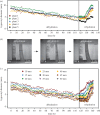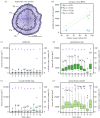How water availability influences morphological and biomechanical properties in the one-leaf plant Monophyllaea horsfieldii
- PMID: 29410820
- PMCID: PMC5792897
- DOI: 10.1098/rsos.171076
How water availability influences morphological and biomechanical properties in the one-leaf plant Monophyllaea horsfieldii
Abstract
In its natural habitat, the one-leaf plant Monophyllaea horsfieldii (Gesneriaceae) shows striking postural changes and dramatic loss of stability in response to intermittently occurring droughts. As the morphological, anatomical and biomechanical bases of these alterations are as yet unclear, we examined the influence of varying water contents on M. horsfieldii by conducting dehydration-rehydration experiments together with various imaging techniques as well as quantitative bending and turgor pressure measurements. As long as only moderate water stress was applied, gradual reductions in hypocotyl diameters and structural bending moduli during dehydration were almost always rapidly recovered in acropetal direction upon rehydration. On an anatomical scale, M. horsfieldii hypocotyls revealed substantial water stress-induced alterations in parenchymatous tissues, whereas the cell form and structure of epidermal and vascular tissues hardly changed. In summary, the functional morphology and biomechanics of M. horsfieldii hypocotyls directly correlated with water status alterations and associated physiological parameters (i.e. turgor pressure). Moreover, M. horsfieldii showed only little passive structural-functional adaptations to dehydration in comparison with poikilohydrous Ramonda myconi.
Keywords: Monophyllaea; Ramonda; biomechanics; drought tolerance; functional morphology; turgor pressure.
Conflict of interest statement
We declare we have no competing interests.
Figures





References
-
- Kiew R. 2009. The natural history of Malaysian Gesneriaceae. Malay. Nat. J. 61, 257–265.
-
- Green TGA, Sancho LG, Pintado A. 2011. Ecophysiology of desiccation/rehydration cycles in mosses and lichens. In Plant desiccation tolerance (eds Lüttge U, Beck E, Bartels D), pp. 89–120. Berlin, Germany: Springer.
-
- Chin SC. 1977. The limestone hill flora of Malaya I. Gard. Bull. Singap. 30, 165–219.
-
- Figdor W. 1903. Über Regeneration bei Monophyllaea horsfieldii R.Br. Österr. Bot. Z. 53, 393–396. (doi:10.1007/BF01791210) - DOI
-
- Ayano M, Imaichi R, Kato M. 2005. Developmental morphology of the Asian one-leaf plant, Monophyllaea glabra (Gesneriaceae) with emphasis on inflorescence morphology. J. Plant Res. 118, 99–109. (doi:10.1007/s10265-005-0195-5) - DOI - PubMed
Associated data
LinkOut - more resources
Full Text Sources
Other Literature Sources
Research Materials

